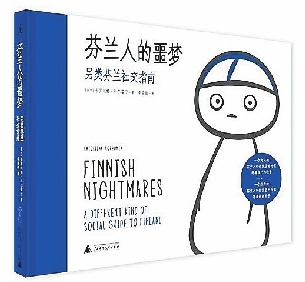
IT’S not a rare encounter to run into an acquaintance but hesitate to greet them, with the end result them walking away fast or pretending to check their phone. Similarly, some might have a question to ask in a public lecture but end up keeping it to themselves because they don’t want to draw attention. These are only two of the awkward moments in the lives of introverted people, who often find socializing challenging. But for Finns, it’s considered part of their culture. In a comic book called “Finnish Nightmares — A Different Kind of Social Guide to Finland,” Finnish graphic designer Karoliina Korhonen shows the inner struggles of a typical Finn, a people who relish personal space and tend to avoid small talk if not forced. In venues ranging from buses and shopping malls to offices and restaurants, the social anxiety of Matti, the book’s protagonist, is fully on display. Social awkwardness has struck a chord with many Chinese people on social media, especially among millennials — who grew up as only children and tend to be more anti-social compared to their parents’ generation. On Douban, a popular Chinese book review website, the comic is rated 7.4 out of 10, with many Internet users calling themselves “spiritually Finnish.” Speaking with China Daily, Yang Xinyi, a Finnish language teacher with Beijing Foreign Studies University, said this is because Chinese people also prefer space to themselves, though Chinese culture has for centuries cherished “renao” — a social atmosphere buzzing with activities and excitement. “Sometimes you enter an elevator and meet an acquaintance. You think you’d better say ‘Hi’ to them, but still feel awkward about speaking first. For many Chinese, we may choose to look down and find refuge on our phones,” Yang said. The comic series was first published on Facebook and the Facebook page “Finnish Nightmares” has so far garnered more than 186,000 likes from people worldwide. Talking about its popularity, Korhonen said the comic was an accidental success. She started with a very simple motivation: to introduce Finnish social culture to her foreign friends. “It started in 2015. I didn’t expect its influence to become this big,” Korhonen said in an interview with China Daily in Beijing on Sunday. “Small talk and kissing cheeks may be part of everyday greetings for people in many countries. But for Finns, it brings us anxiety.” The comic was originally drawn in English and translated back to Finnish. Now it’s published in many other languages such as Japanese, Korean and Chinese. Nurturing an interest in graphic art since the age of 13, Korhonen said she hopes her drawings would help people around the world better understand Finnish culture. Her next book will be centered around Finnish proverbs and sayings, which she said are largely influenced by the country’s fondness for nature and animals. (China Daily) | 
